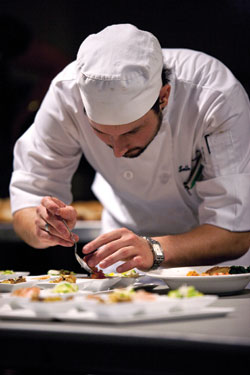Before Renee Zonka was named as Dean of Kendall College, she had extensive experience as an off-premise caterer.
 "Starting in the 1970s, I was involved with catering both out of the house and through both foodservice operations and catering companies," Zonka says. "I've handled functions for up to 5,000."
"Starting in the 1970s, I was involved with catering both out of the house and through both foodservice operations and catering companies," Zonka says. "I've handled functions for up to 5,000."
After receiving her bachelor's degree in food and nutrition from Loyola University, Zonka became the executive chef at a hospital and opened a 90-seat public restaurant in the lobby. She then joined Marriott Management Services, where she ran multiple foodservice operations for 11 years and simultaneously completed her master's degree at the Lake Forest Graduate School of Management.
FE&S spoke with Zonka about all aspects of the catering segment.
FE&S: What makes the catering segment unique?
RZ: This segment is individualized. Caterers make plans with a client and service their specific needs. These operators can be very creative and work in exotic places. For example, I catered a wedding for witches that took place in a corn field with a bonfire. I was able to tap into my creative side in terms of menu, environment, layout and design.
FE&S: What are some trends shaping this foodservice segment today?
RZ: More and more caterers are accepting non-traditional events. There also has been an increase in catered events. There's a misnomer that it's cheaper [than having an event at a restaurant], but it's not. There's the cost of hiring additional staff, taking food to the venue, and the expense of vehicles used to carry food and equipment.
FE&S: What equipment innovations are driving this segment?
RZ: Equipment integral to catering includes "caves" or tall carts with doors. Caterers put sheet pans in these and flip them into ovens, put heating gels in the carts or right under sheet pans or use pans as grills to sear product. Some hot boxes can be used as refrigerators with the addition of dry ice. Sous vide equipment has revolutionized catering, allowing these operations to prepare hundreds of portions ahead of time, vacuum seal the food and reheat it at the site. Caterers also use liquid nitrogen to produce ice cream. Anti-griddles can freeze sauces, toppings and other liquids for easier transport. There are a number of fun, innovative techniques that have been unveiled. With the increased popularity of food and catering trucks, these operators are able to finish off food in these vehicles. A really good catered event doesn't just happen. Caterers need time to plan and take costs into consideration.
FE&S: From an operator's perspective, what are some of the benefits of the catering segment?
RZ: Caterers can charge more because there is a higher contribution margin. When pricing out for a restaurant, operators charge two-and-a-half times the food cost. Caterers charge four-and-a-half times the food, rental and labor costs. Although catering operations do not double their profits, the revenue is greater. On the downside, catering requires planning and is more labor intensive for the administrator. There also is a risk/benefit; a client that is happy with an event may result in a growing clientele.
FE&S: Describe a challenging event you have been involved with.
RZ: I catered a '50s [themed] event for a group of 5,000. It included various food kiosks, cars from that era and elaborate décor. This job wasn't just about the food. Catering can also include providing staff, décor and equipment. I've catered for the U.S. Open and U.S. Senior Open golf tournaments. It can be a challenge feeding thousands of people out of a refrigerated trailer. This type of event can be a very physical endeavor that requires a lot of labor to make it happen. The planning portion requires a lot of time. All scenarios have to be considered. Still, these opportunities provide good visibility for caterers and restaurants that provide catering services.
FE&S: What are the biggest challenges operators in the catering segment need to address?



